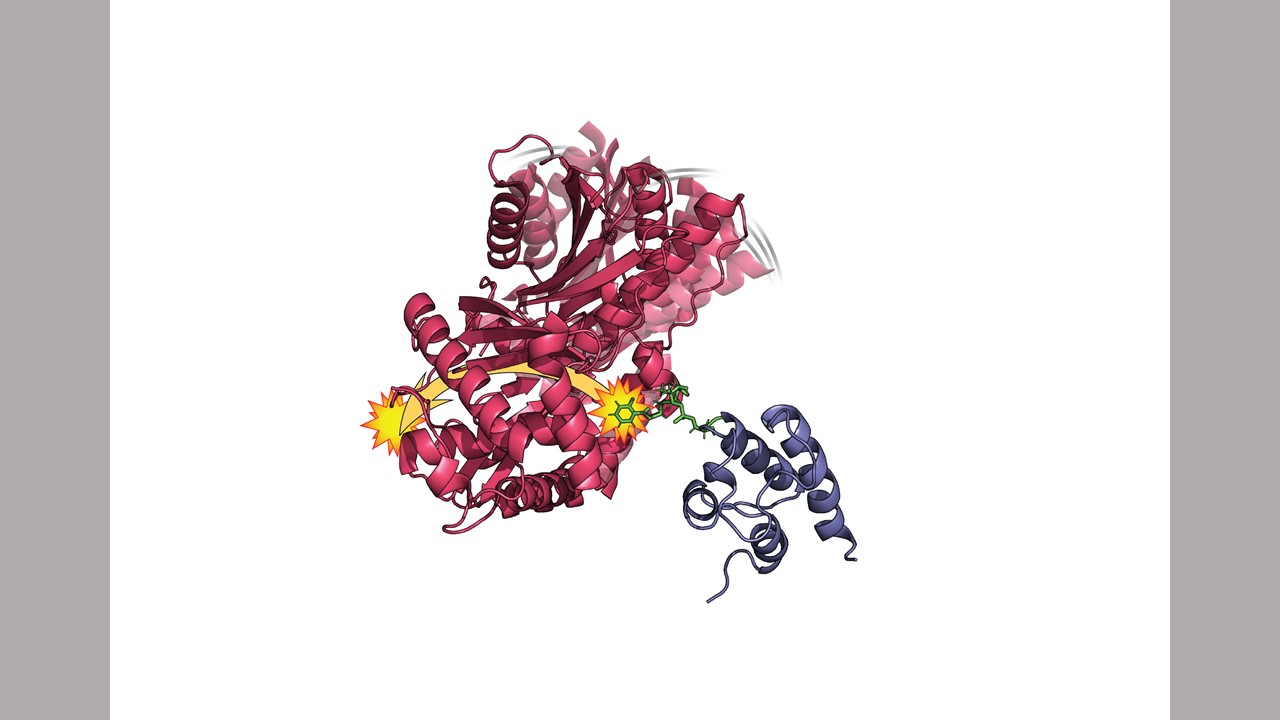
Structural illustration of the HMWP2 enzyme domains, highlighting two interacting domains (shown in red and blue), the two remote binding sites (yellow stars), and the modification of one domain (green). Credit: Kenny Marincin and Dominique Frueh, Johns Hopkins
Johns Hopkins Medicine scientists report they have probed the atomic structure of proteins to add to evidence that the wobbles, shakes and quivers of proteins play a critical role in their ability to function. The findings of the research may help scientists design new drugs that can modify or disrupt the intricate "dances" of proteins to alter their functions.
Results of the researchers' experiments will be published in the July 15 issue of Science Advances.
Proteins are organic compounds with blueprints that are found in DNA, and which function as the "business ends" of biology, making up the structural components of tissues, along with enzymes, which orchestrate chemical changes within cells.
Though it has long been known that proteins wiggle and move, scientists have debated the significance of this "dancing" act, says Dominique Frueh, Ph.D., associate professor of biophysics and biophysical chemistry at the Johns Hopkins University School of Medicine. "The way proteins engage with the right partner at the right time - essentially, how they communicate - is very important for understanding their function," he says, "and we have found that protein wiggles are critical for this communication."
In a bid to further such understanding, Frueh's team studied the wiggling action of the HMWP2 protein, a type of enzyme called nonribosomal peptide synthetases. These enzymes are made of several domains, or distinct regions, that work together like an assembly line to make complex natural products from small chemicals.
These natural products often have pharmaceutical properties, such as bacitracin, found in topical antibiotic ointments. In the case of HMWP2, its product is yersiniabactin, a molecule that scavenges iron molecules for bacteria, including Escherichia coli, found in urinary tract infections, and Yersinia pestis, the bacterium that causes bubonic plague.
Frueh says that understanding how protein domains work together could enable scientists to modify the domains to make them produce new chemicals.
In general, the team found that the widespread wiggling of one domain in the HMWP2 enzyme kick-starts a process that enables the domain to connect with several partner domains at one time.
To determine the importance of protein movement, the scientists tracked the motion of one of HMWP2's domains down to each individual atom in the molecule using nuclear magnetic resonance (NMR) spectroscopy, a device that uses powerful magnetic fields to probe the molecular environments of nuclei within the center of atoms.
Although NMR is often used to determine small protein structures, tracking the motions within large proteins with the device is difficult. To overcome this challenge, Frueh's team, including NMR scientist Subrata Mishra, Ph.D., graduate student Kenneth Marincin, and postdoctoral fellow Aswani Kancherla, Ph.D., used nitrogen-15 and carbon-13 - naturally occurring forms of nitrogen and carbon - to flag two domains of the HMWP2 enzyme and track the change in motion of one domain when a second domain was modified, as occurs when the enzyme makes its natural product.
"We found that the two domains would only bind to one another as the second domain gets modified, which means they would only engage as needed for making the product and avoid wasting time together when the second domain is not modified," says Frueh. "Somehow, the first domain is able to sense when the second domain is modified, and we sought to investigate whether motions played a role in this recognition process."
They also found changes in motion across the entire domain flagged with carbon-13c, not only where it binds to the second domain but also at a second, remote binding site used by a third domain.
On an atomic level, Frueh says these two sites on HMWP2 could be considered "far" apart - about 40 billionths of a meter. And how they interact, despite their distance, was particularly intriguing to the scientists.
To show that movements facilitated the interaction with the remote site and the sensing of the second domain modification, the scientists genetically engineered HMWP2 proteins with a mutation that occurred in a location on the domain far from the two sites the scientists had identified. Thus, the mutation did not directly block the sites' ability to interact with other domains.
"We found that the protein domain was structurally stable, but all of its movement was hindered," says Frueh. The mutated protein's lack of movement damaged its ability to bind with other domains even when they were modified, according to the researchers, demonstrating that the motions within the protein were necessary for the domains to work together.
Frueh notes that detailed knowledge of protein movement could be leveraged by scientists designing new drugs that don't target a protein's natural active site but instead halt its movement to inactivate it. Such an approach could offer more leeway to design drugs with fewer unwanted side effects, he says.
To this aim, Frueh says, researchers are studying how computation and artificial intelligence can improve the understanding and prediction of protein movement.
Funding for the research was provided by the National Institutes of Health's National Institute of General Medical Sciences and the National Institute of Allergy and Infectious Diseases (R01GM104257, R15GM123425, R35GM125034, R01Al143997).
Other researchers who contributed to the study are Guillaume Bouvignies from the École Normale Supérieure in Paris; Santrupti Nerli from the University of California, Santa Cruz; Nikolaos Sgourakis from the University of Pennsylvania and Daniel Dowling from the University of Massachusetts.






